Venus continues to dominate in the morning, along with a retinue of fellow planets gracing the predawn sky. Mars, Saturn, and elusive Mercury provide lots to observe. Jupiter largely is hidden from view after its conjunction with the Sun. Meanwhile, the evening sky carries William Herschel’s great discovery of 1781, the planet Uranus, easily visible in binoculars.
Let’s start with a closer look at this distant giant. The only planet visible in the evening sky is 6th-magnitude Uranus, nestled within a dim region of Aries the Ram. It stands due north of the circle of stars depicting the head of Cetus the Whale.
The easiest way to find the field of view containing Uranus as you scan around with binoculars is to draw a line between Hamal, the brightest star in Aries, and Menkar, the brightest star in Cetus. Uranus lies midway between these two easy-to-spot 2nd-magnitude stars.
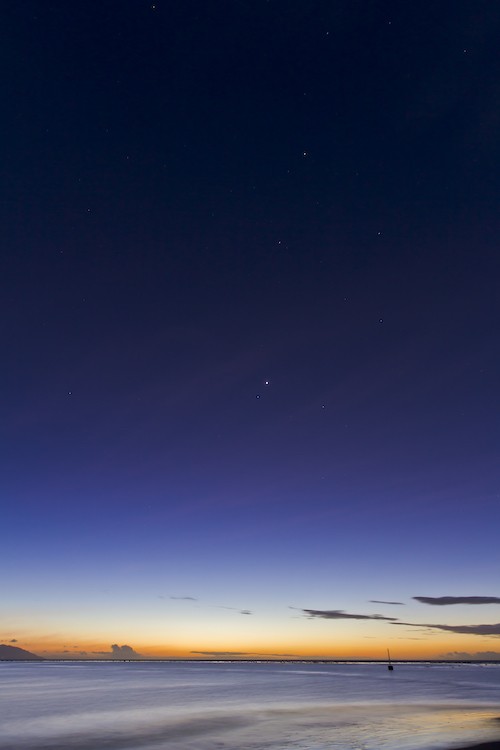
Mercury, Venus, Mars, and Saturn share the sky in July 2010. This month, the same planets appear in the morning twilight, with Mercury ducking out early and Jupiter joining in late March.
Once you’re in the right vicinity, look for a pair of stars within the field of view of 7x50 or 10x50 binoculars. The two stars you’re looking for are Omicron (ο) Arietis and 29 Arietis, both about 6th magnitude and separated by 2.8°. Uranus wanders northeastward during March, starting from a point 44' southeast of 29 Ari. The planet will appear slightly bluish under good transparent skies.
A useful guide is the waxing crescent Moon, which sits in Aries March 6 — a lovely sight in the evening sky. Swing your binoculars between 3° and 4° northeast of our satellite to find Uranus.
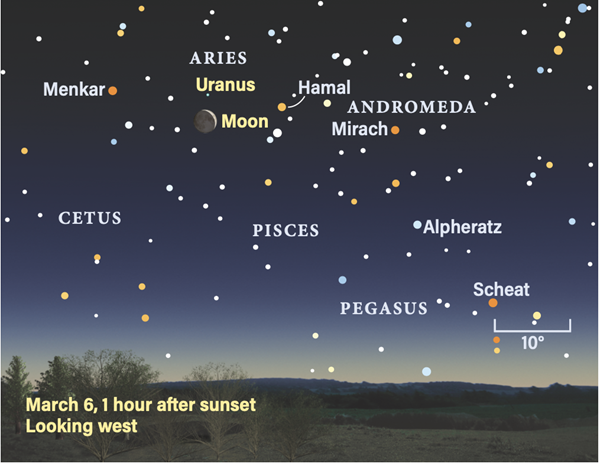
An evening guide: Uranus sits between the bright stars Menkar and Hamal. On March 6, a crescent Moon also helps guide the way, hanging just southwest of the ice giant.
From March 14 to 23, Uranus stands within 18' of a 7th-magnitude red giant field star, and their color contrast is noticeable. It’s an especially fine view using an APO refractor, which has good color rendition. Notice the brighter blue supergiant, Omicron, standing just over 1° to the east. For the remainder of March, Uranus heads toward Omicron, ending the month 0.8° due west of the star.
Switch to a telescope to view Uranus’ distinctive bluish-green disk, which spans just over 3". This distant giant lies 1.9 billion miles from Earth.
To observe more planets, set your alarm early to catch a spectacular show in the predawn sky, starring Venus, Saturn, and Mars.
Venus is first up in the morning sky, rising more than two hours before the Sun March 1st. Mars rises within half an hour of Venus, and the two stand 5° apart in eastern Sagittarius. Venus is dazzling at magnitude –4.7, while Mars is a relatively dim magnitude 1.3. Over the month, Venus dims to magnitude –4.4 and Mars brightens to magnitude 1.1.
Mars appears as a glowing, amber-colored jewel compared with the stunning white sapphire glow of Venus. They trek in tandem across Sagittarius, reaching Capricornus March 6. You’ll find them 3.9° apart — their closest — March 15. Venus’ continued daily drift against the backgrounds stars remains faster than Mars’. The brilliant planet soon forms the apex of a triangle with Mars and Saturn, which lies farther east and glows at magnitude 0.7 all month.
Venus reaches its greatest elongation on March 20, when it stands 47° west of the Sun. Check it out with a telescope to reveal a 50-percent-lit disk spanning 25". Due to the Schröter effect, reported in the 1790s by German astronomer Johann Schröter, the visual moment of dichotomy (when the planet is 50 percent lit) appears later than predicted during morning apparitions. This is likely a combined effect of the refraction of light through the upper clouds of Venus combined with perception effects by the visual observer. When do you observe dichotomy?
On March 24 and 25, Venus is roughly equidistant (4° to 5°) from Mars and Saturn. The elegant triangle of planets stands 8.5° high an hour before sunrise. A waning crescent Moon lies in Sagittarius on the 25th.
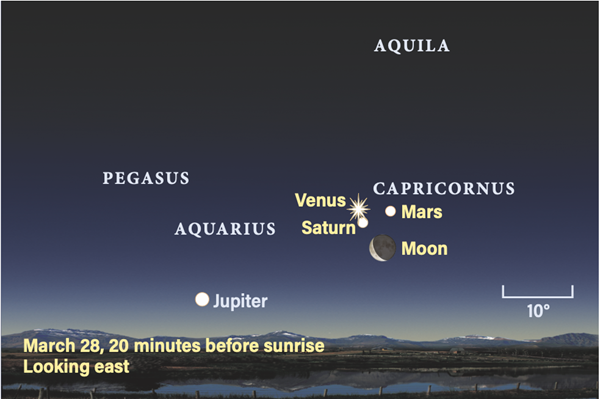
Twilight portrait: The Moon and planets are out to play by March 28 — including Jupiter, which sits low in twilight. Those with a clear eastern horizon may spot it.
The best scene of the month occurs March 28, when a 26-day-old crescent Moon joins the planetary trio. Our satellite stands 6° below Mars, while Saturn and Venus are 2.2° apart 6° north of the Moon. It’s a stunning spectacle that’s exciting to follow as twilight proceeds. Grab some photos of this elegant morning scene and enhance it with suitable silhouette features such as a windmill, trees, or stylish buildings.
A visual treat awaits the observer with a telescope. Venus spans 23" and now displays a 54-percent-lit disk. Saturn’s 16"-wide globe, surrounded by its famous rings, provides dramatic contrast. Mars remains a tough observational target (and will for some months), spanning a mere 5".
Try following Venus into daylight, when you can achieve better views of its cloud tops by avoiding the glare that occurs when it’s in a darker sky. On March 31, Venus and Mars are 6° apart, with Saturn now neatly situated between them.
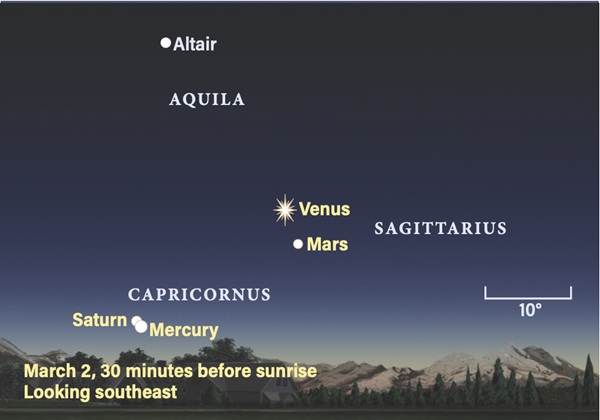
Close encounter: Mercury is visible early in the month. Catch it standing just 42" south of Saturn on the 2nd.
Mercury remains visible in early March. You can catch it just 42" south of Saturn on March 2 when they rise shortly before 6 A.M. local time. Mercury shines at magnitude –0.1, brighter than Saturn. Try to spot the pair 30 minutes after they rise, when they stand 6° above the eastern horizon. Venus lies 22° farther west along the ecliptic, already 20° high.
Mercury quickly descends deeper into twilight and becomes harder to spot. Can you see it 2° high on March 9, just 20 minutes before sunrise? Soon after this, Mercury disappears, continuing toward its early April superior conjunction. Meanwhile, Saturn climbs higher each morning.
Jupiter reappears briefly in the morning sky at the end of the month, following its March 5 conjunction with the Sun. See if you can spot the magnitude –2.0 planet at the end of the month, standing just 2° high in the eastern sky in the 30 minutes before dawn. Telescopic viewing of the giant planet will have to wait a month or two. Venus, Saturn, and Mars stand 10° higher in the southeast.
The spring equinox occurs March 20 at 11:33 A.M. EDT. It’s the transition from northern winter to spring, offering equal sunlight in both hemispheres.
Neptune reaches conjunction with the Sun March 13. It is not visible this month.
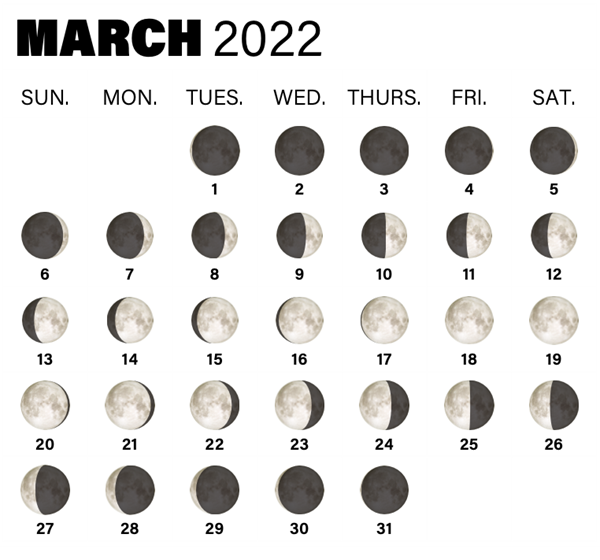
Note: Moon phases in the calendar vary in size due to the distance from Earth and are shown at 0h Universal Time.
Rising Moon: More hopeful by the day
Spring crescents are the best! With the Moon standing high above the horizon, you’ve got time to explore Luna’s eastern limb, where shadows abound. On the 3rd, perhaps the only recognizable features north of the equator are Mare Humboldtianum and the 110-mile-wide Gauss.
Come back on the 4th to see Hahn and Berosus sporting bright rims in the sunshine, their bowls in shadow. Friedrich von Hahn was a dedicated amateur astronomer in the late 1700s who discovered the Ring Nebula’s (M57) central star. Berosus was a 3rd-century B.C. astronomer who realized the Moon spun once on its axis for each revolution around Earth, explaining why we always see the same face.
Lacus Spei, the Lake of Hope, has tasted morning Sun by the 5th. It’s about halfway between Gauss and the notable flat-floored Endymion. Can you see Spei’s splotch? Perhaps not with the mixed shadowed terrain, but in a few nights its darkness will stand out. It might be an old mare that never got covered, or the sooty apron from a shallow volcanic cone.
A dynamic phenomenon to watch is the night-by-night backward tilt of Gauss and Humboldtianum away from us and toward the limb, which occurs from the 4th through the 10th. The Moon does not really rock like that — it’s a trick of perspective when our satellite climbs above the ecliptic and bares its underside. This libration also lets us see more of the west and less of the east because the Moon is in a slower part of its orbit, letting its constant turning get ahead.
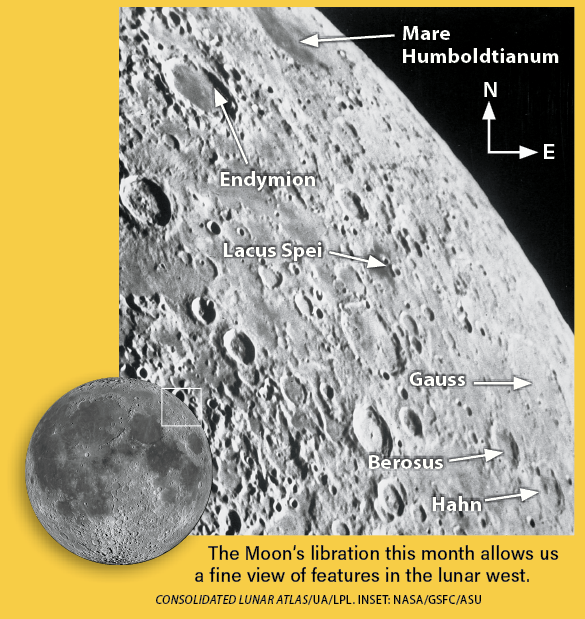
Meteor Watch: Focus on the sky
For the second month in a row, no major meteor showers occur. This offers two opportunities for observers. One is looking for the background, or sporadic, meteor rate. The best times this month occur during the dark Moon period beginning March 1. A First Quarter Moon on March 9 sets before 2 A.M. local time, offering dark morning skies. Sporadic rates average a half-dozen meteors per hour. Morning skies are best because you’re on the leading hemisphere of Earth as we orbit the Sun, so meteors strike the atmosphere head-on. Evening rates tend to be lower as we look back along our orbit, as if viewing out the rear-facing window of planet Earth, so meteors have to catch up with us.
The second opportunity for observers this month is viewing the zodiacal light in the evening sky. Your best chances are the first few days of March before the Moon interferes and the last week of the month, when again the Moon is out of the way.
Zodiacal light comes from sunlight reflecting off fine dusty debris littering the inner solar system. This is the detritus left by ancient comets. Once twilight has faded, look for a delicate cone-shaped glow extending above the western horizon. You’ll need a very dark moonless sky with no interfering lights. The zodiacal light is aligned with the ecliptic, Earth’s orbital plane, and passes through Pisces, Aries, and Taurus. Try using peripheral vision to spot the arching cone of light by scanning left to right along the horizon.
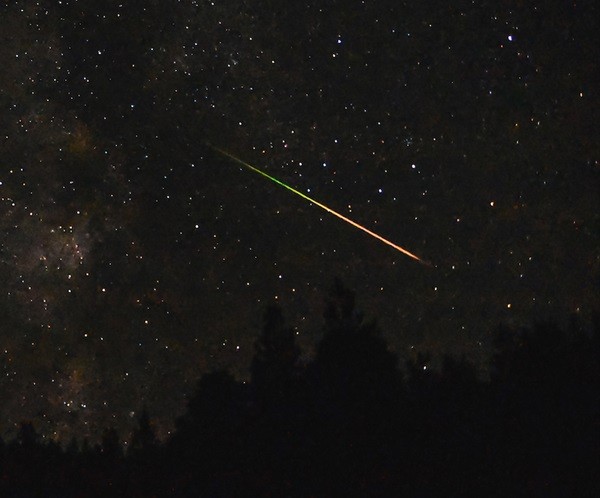
Chance sighting: A sporadic meteor that is not associated with a shower streaks across the sky in July 2020.
Comet Search: Goin' to California
Take advantage of two dark-sky windows to view the departing Comet 19P/Borrelly. The comet starts off March near the magnitude 3.6 guidepost 41 Arietis, halfway between the Pleiades (M45) and the familiar hockey stick shape of Aries. Glowing at 10th magnitude, Borrelly will be a fair bit dimmer than M1 far to its southeast — the object that started comet hunter Charles Messier on his journey to creating the Catalogue of Nebulae and Star Clusters.
Tough for a 4-inch scope, the ball of dust and ice will be within reach of a 6-inch aperture under dark skies. At powers above 150x, the north limb of the inner coma will be sharply defined, hiding the actual nucleus from sight, while a stubby fan diffuses out to the south. The Moon interferes for the middle two weeks of the month.
Sporting a period of 6.8 years, Borrelly returns as a binocular comet with a very favorable apparition in December 2028.
And there’s more! The photogenic field between M35 and the Rosette Nebula (NGC 2237) hosts two fainter comets: 104P/Kowal and C/2019 L3 (ATLAS). Comet 67P/Churyumov–Gerasimenko is nearby in Cancer. Visual observers will want to switch to the brighter C/2017 K2 (PanSTARRS) in Aquila after midnight.
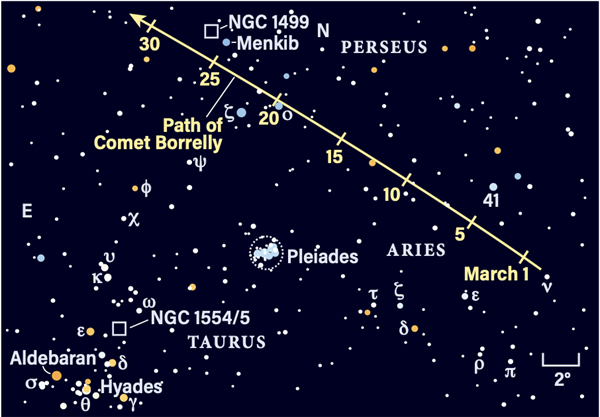
Comet 19P/Borrelly: Wide-field astroimagers get a nice treat starting March 25, when Comet Borrelly slides less than 2° south of the California Nebula (NGC 1499). It sits on the state’s southern border the 27th.
Locating Asteroids: Climbing the horns of the Bull
High in the southwest, ruddy Aldebaran seems to keep an eye on the ruler of the asteroid belt climbing up Taurus’ northern horn. Dwarf planet 1 Ceres remains a straightforward target for a 60mm refractor from the suburbs, even as it slowly fades out of binocular reach.
On its inside track around the Sun, Earth overtook Ceres a few months ago, leaving it to travel eastward on a straight path near the ecliptic. Halfway between the Hyades and Pleiades, Ceres lies near the magnitude 4.4 star 37 Tauri. In this younger section of the Milky Way, the dichotomy of faint and bright stars provides recognizable patterns for you to latch onto. To watch the dwarf planet shift spots in one observing session, use it as a third point of some notable triangle and note how the shape morphs after a three-hour span.
If you’re at the Crab Nebula (M1) during a Messier marathon at month’s end, pop up to the field just north of Tau (τ) Tauri, nab Ceres, and watch the stars vanish into the trench of dark nebula Barnard 19, an envelope for several smaller and deeper dust clouds.
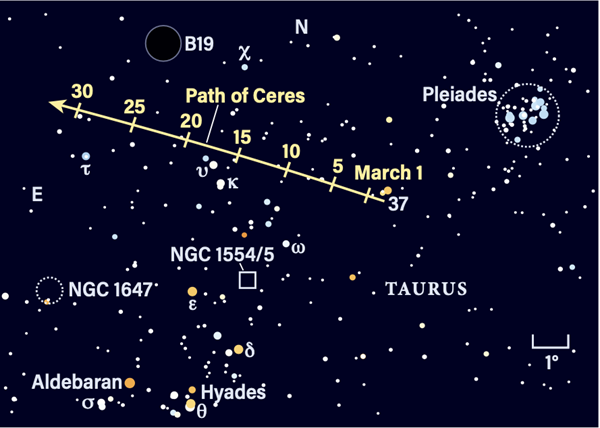
Through dark and light: Ceres travels up the star-studded face of Taurus the Bull this month.
Source: Astronomy Magazine